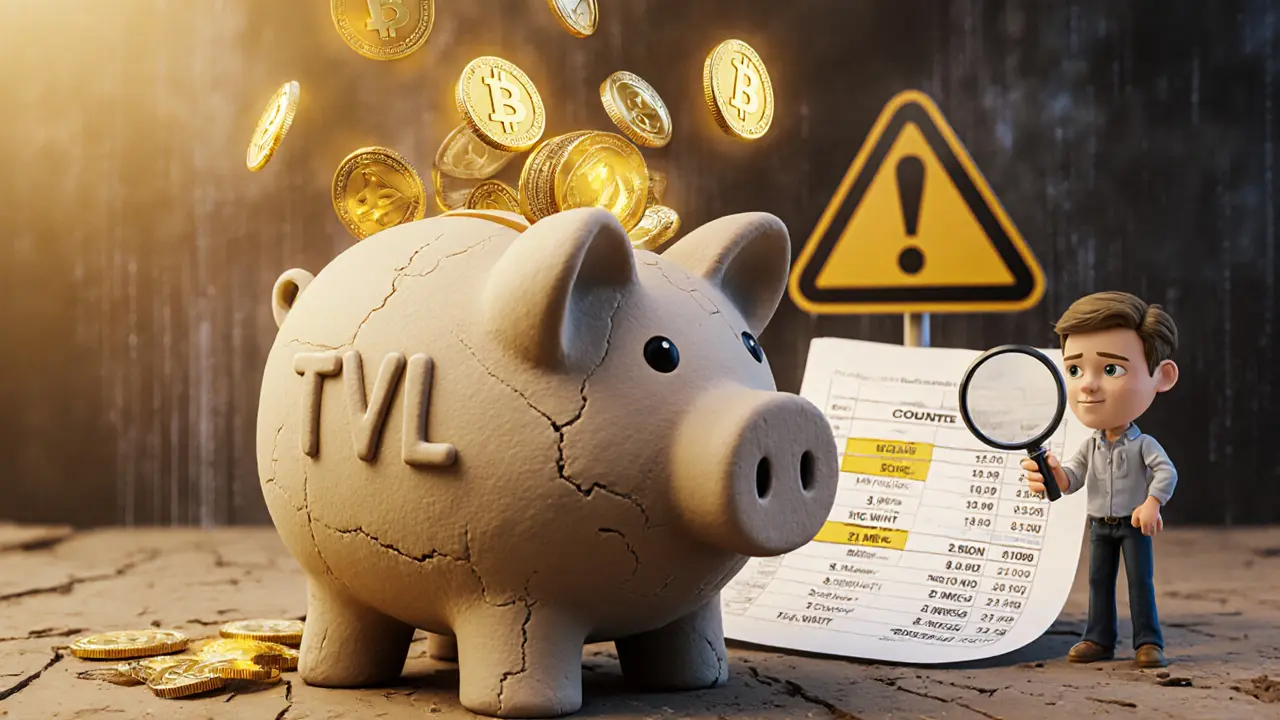How TVL Is Calculated in DeFi: The Real Method Behind the Numbers
 Aug, 30 2025
Aug, 30 2025
DeFi TVL Accuracy Calculator
Understand TVL Calculation Accuracy
Calculate both standard TVL and verifiable TVL (vTVL) to see how common pitfalls like double-counting, unstable price feeds, and tokenomics tricks affect reported values.
Standard TVL Calculation
Asset Value:
Verifiable TVL (vTVL)
Verified Value:
When you see a DeFi protocol boasting $2 billion in TVL, what does that number actually mean? It’s not just a fancy statistic-it’s the total amount of crypto locked up in smart contracts across lending, staking, and liquidity pools. But here’s the truth: TVL calculation isn’t as simple as adding up numbers. Behind every big figure is a messy, inconsistent, and often misleading process.
What TVL Actually Measures
TVL stands for Total Value Locked. It’s meant to show how much capital users have committed to a DeFi protocol. If you deposit 10 ETH into a lending platform to earn interest, that ETH gets counted in the protocol’s TVL. Same if you add liquidity to a decentralized exchange like Uniswap-your tokens are locked in a smart contract, and their value gets added to the pool’s TVL. But TVL doesn’t tell you if the protocol is profitable. It doesn’t tell you if users are making money. It doesn’t even tell you if the platform is safe. It only shows how much money is sitting there. Think of it like counting how many cars are parked in a lot. It doesn’t tell you if the cars are running, who owns them, or if they’ll be there tomorrow.The Four-Step TVL Calculation Process
Despite how messy things get, there’s a basic formula everyone tries to follow:- Identify the assets - What tokens are locked? ETH, USDC, DAI, WBTC, or some obscure token from a new project?
- Count the quantity - How many units of each token are in the contract? A simple on-chain balance check.
- Get the current price - What’s each token worth in USD right now? This is where things go wrong.
- Add it all up - Multiply quantity by price for each asset, then sum the results.
Example: A protocol holds 3,000 ETH and 500,000 USDC. ETH is trading at $3,200. USDC is $1.00. TVL = (3,000 × $3,200) + (500,000 × $1) = $9,600,000 + $500,000 = $10.1 million.
Looks clean. But that’s only on paper.
Why TVL Numbers Are Often Wrong
The biggest problem? Price feeds. TVL depends entirely on real-time market data. If ETH spikes 15% in an hour, TVL jumps. If a stablecoin depegs-even slightly-TVL drops. But not all platforms use the same price sources. Some use Chainlink. Others use unverified APIs from third parties. Some even pull prices from centralized exchanges like Binance, which can be manipulated. Then there’s double counting. A lot of protocols issue derivative tokens when you deposit. For example, you deposit ETH into a staking pool and get back “stETH.” That stETH might then be deposited into another protocol. Now both the original ETH and the stETH are counted in TVL-even though it’s the same underlying asset. That inflates numbers. A 2024 study found that up to 30% of reported TVL across major DeFi aggregators could be double-counted. And don’t forget tokenomics tricks. Some projects create fake demand by rewarding users with their own tokens. Those tokens get locked in TVL, but they’re worth almost nothing. A protocol might report $500 million in TVL, but $400 million of that is in a token with a $0.01 market cap. That’s not real value-it’s a numbers game.
Verifiable TVL (vTVL): The Fix Nobody’s Using
Researchers at the Bank for International Settlements studied 939 DeFi protocols and found something alarming: only about half of them could have their TVL verified using only on-chain data. The rest relied on self-reported numbers, private APIs, or off-chain servers. That means if a project says it has $1 billion in TVL, there’s no way to prove it without trusting them. That’s why “verifiable TVL” (vTVL) was created. vTVL only counts assets that can be confirmed through standard blockchain queries-no external data, no manual input. It’s stricter. It’s slower. But it’s honest. A 2025 analysis of 400 protocols showed that only 46.5% of their published TVL matched their vTVL. That’s nearly half of all DeFi projects reporting inflated numbers. And the biggest aggregators-DeFiLlama, DefiPrime, CoinGecko-are still using the old, sloppy method. Why? Because inflated TVL attracts more users and more investment.TVL vs. Real Risk: The Hidden Gap
TVL doesn’t measure risk. It measures volume. Two protocols can have the same TVL but wildly different safety levels. Take a lending protocol that requires 150% collateral. That’s safe. Now take one that only requires 110% collateral-and uses volatile tokens as collateral. Same TVL. But if ETH drops 20%, the second protocol could collapse. TVL won’t warn you. Some analysts now track “Total Value at Risk” (TVR)-how much money could be lost if things go wrong. In 2024, one study found TVR was 50% lower than TVL for most protocols. That means half the locked value isn’t actually at risk. But nobody tracks TVR publicly. So investors are flying blind.
What You Should Do Instead
Don’t use TVL as your main decision-maker. Here’s what to look at instead:- On-chain liquidity depth - Is the protocol’s liquidity spread across many wallets, or concentrated in a few?
- Protocol revenue - Does it earn fees? How much? TVL tells you nothing about income.
- Collateralization ratio - What’s the minimum deposit needed to borrow? Higher is safer.
- Token distribution - Are the rewards paid in real assets or in the project’s own low-value token?
- Smart contract audits - Has it been audited by a reputable firm? How many issues were found?
TVL is like a car’s odometer. It tells you how far you’ve driven, but not how fast you’re going-or if the brakes work.
The Future of TVL
Regulators are starting to pay attention. In 2025, the U.S. SEC signaled it may require DeFi platforms to disclose how they calculate TVL. If that happens, we could see standardization. Maybe even mandatory vTVL reporting. Some protocols are already moving toward transparency. Aave now publishes its vTVL alongside its regular TVL. Curve has started excluding derivative tokens from its public numbers. These are small steps-but they matter. For now, treat every TVL number with skepticism. Look at the source. Check if it’s verifiable. Ask: Is this real value, or just a number designed to look impressive?Why TVL Still Matters
Even with all its flaws, TVL is still the most widely used metric in DeFi. It’s the first thing investors check. It drives funding, partnerships, and media coverage. Ignoring it isn’t an option. But understanding how it’s calculated-and how it’s manipulated-is the only way to use it wisely. TVL isn’t a score. It’s a starting point. The real work begins after you look at the number.Is TVL a good indicator of a DeFi project’s success?
TVL shows how much money is locked in, but not whether the project is profitable, safe, or sustainable. A high TVL can mean popularity-or a pump-and-dump scheme. Always check revenue, audits, and collateral ratios alongside TVL.
Can TVL be manipulated?
Yes. Projects can inflate TVL by issuing low-value tokens, double-counting assets, using fake price feeds, or incentivizing deposits with high rewards. Many aggregators still accept self-reported data, making manipulation easy.
What’s the difference between TVL and vTVL?
TVL is the total value reported by a project, often using off-chain or self-reported data. vTVL (verifiable TVL) only includes assets that can be confirmed using on-chain data and standard blockchain queries. vTVL is more reliable but usually lower.
Why does TVL change so quickly?
TVL changes because it’s based on live crypto prices. If ETH rises 10%, TVL jumps-even if no one deposited or withdrew. Also, users constantly move funds in and out of protocols, especially during market swings.
Should I invest in a DeFi protocol just because it has high TVL?
No. High TVL doesn’t mean high returns or safety. Many high-TVl protocols have failed because of poor design, low revenue, or rug pulls. Always dig deeper into how the protocol earns money, who controls its smart contracts, and whether its token has real utility.
Michael Labelle
November 26, 2025 AT 10:26TVL is just the appetizer. I’ve seen projects with $500M TVL that couldn’t pay their dev salaries. It’s like judging a restaurant by how many plates are on the table, not whether the food tastes good.
Always check revenue streams first. If the protocol isn’t earning fees or burning tokens, that TVL is just a balloon waiting to pop.
Vance Ashby
November 28, 2025 AT 01:56lol yep. TVL is the crypto equivalent of ‘likes’ on TikTok. Just because 10M people watched doesn’t mean the video is good. I saw a project with $2B TVL that was just 1.8B in their own useless token. 😅